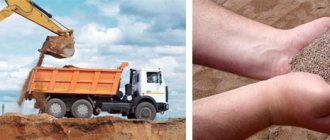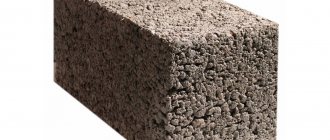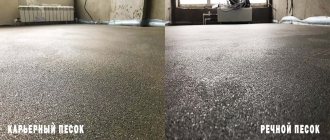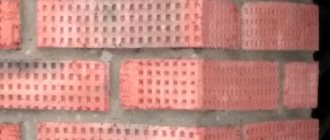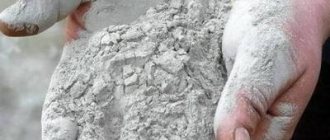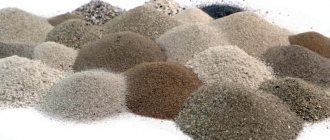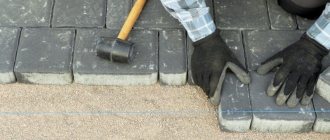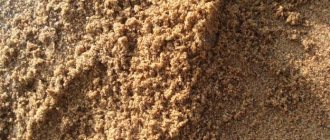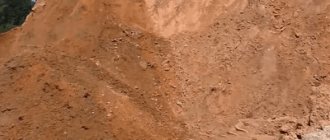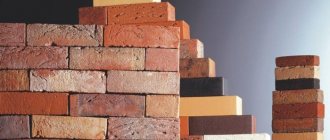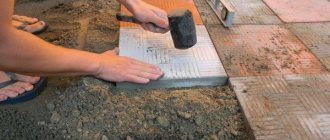What kind of sand is needed for bricklaying
When it comes to building walls, the question of what kind of sand is needed for laying bricks is often discussed.
Indeed, before you start laying the first row, it is wise to understand this issue. Especially for beginners. After all, it is beginners who are often surprised to discover that sand has many varieties. River, sea, gully, quarry - these are just a few of all the types.
For example, river sand. It is highly prized for its exceptional purity. If you magnify the grains of sand several times, you can see beautiful glossy pellets in front of you.
It is believed that it is precisely because of the smooth surface of sand grains that the adhesion of river sand and cement in mortar is always weaker. Therefore, builders have different attitudes towards the use of this sand.
Some masters prefer to work with him. Others argue that when using it, the plasticity of the working solution decreases. There are also jokers who notice that everything will get mixed up in a concrete mixer anyway.
Or gully sand. Its grains of sand are uneven and rough. This means that the strength of the mortar with this sand increases. Gully sand is also valued for its fairly high clay content, which allows for high-quality plastering and masonry work.
Quarry sand is also very popular. The peculiarity of this natural material is the heterogeneity of its composition and the presence of numerous foreign impurities.
Of course, the technical characteristics deteriorate from this. Therefore, after extraction, this type of sand goes for additional cleaning and processing. It is sifted or washed with water.
Which sand is best for masonry and how to properly prepare the mixture?
As a rule, river sand is considered the most suitable for bricklaying for stone and masonry work. Because it has all the necessary properties that are so necessary for the integrity of the structure for a long time.
River sand, as a rule, is lifted from the bottom; it does not contain small particles of clay, which is good for the solution. Sand comes in several fractions: fine, medium-sized sand grains and coarse.
It is used not only in brickwork, but also for serious concrete production work. It is also used to make asphalt concrete mixtures, and is also very effective as a filler for grouts and dyes.
Masonry, which is usually used in conventional industrial buildings, is affected by shear and compression forces, where tensile strength is completely absent.
This tells us that even with a low cement content in the mortar, we can use it for laying brick structures. In another way he is called skinny among the builders. The working solution for laying brick elements is usually prepared from three components: water, sand filler and a binder - cement.
The sand must be cleared of impurities and excess debris, and the cement must also not have lumps. It is also advisable to use river water, but you can also use regular water from a well.
After this, the sand is called: seeded and alluvial.
By getting rid of soil and clay impurities, alluvial sand becomes suitable for any construction work. It is used to make dry construction mixtures, prepare high-quality concrete and much more.
Of course, it is also perfect for laying bricks.
There is no need to argue for a long time about which sand to choose. In fact, each of the above types is used for bricklaying.
Simply, using their preferences, experience or the type of work being carried out, some craftsmen choose river sand, while others prefer to work with quarry sand. Therefore, advice to beginners: try to acquire knowledge, personal experience and constantly consult with professionals.
Posted on Oct 26, 2017
- Download price
- Laboratory
- Information
- Diplomas
- GOST standards
- Contacts
- Company CBI-3
- Services
- Concrete
Concrete
- Concrete
- Solutions
Solutions
- Cement-sand mortar
- Armature
Armature
- Armature
- Cement
Cement
- Bulk cement
- Inert materials
Inert materials
- Inert materials
- Delivery
Roman, buyer
I contacted CBI-3 when I needed to purchase concrete in bulk. More was planned.
Stone work - the importance of sand
Typically, “bricklaying sand” is added in a certain amount to the general mortar. The amount of sand added depends directly on the final required volume of solution. When laying, the origin of the brick is taken into account, because the plasticity of the mortar may need to be special for hollow or solid bricks.
Sand plays the role of a filler, which means it can be used to regulate the plasticity of the solution. With a hollow brick, the consumption of cement mortar will be greater, since it will fall into the voids of the stone, filling them.
You just have to take into account the fact that a solution created with little mobility spends extra time on the correct laying of brick stones. Because squeezing out excess mortar and adjusting it to the desired thickness of the seam takes the mason much longer than with liquid mortar.
Which sand is best for bricklaying: features
11.10.2018 | |
Sand for bricklaying, standards and requirements.
Before you begin construction work, you should determine what kind of sand for mortar you should purchase. Today we will look at all the nuances and subtleties of this issue. Let's consider the technical characteristics of various types of sand.
We will find out the opinions of experts about which sand is used for bricklaying and which for finishing, cladding buildings and other objects. We hope that this information will help you decide on the choice of sand for mortar.
Brick buildings require special fastening mixtures consisting of a binder - cement, filler and water. Sand is most often used as a filler, since with its help the masonry mortar becomes not only durable, but also plastic.
In addition, it performs several more quite important functions in the solution:
- Allows you to make the masonry even by filling the voids formed due to unevenness in the brick.
- Regulates the volume of solution.
- Reduces the degree of shrinkage of structures.
In addition to sand, special plasticizers can also act as a filler, but in terms of cost, such components are much more expensive. Therefore, when mixing masonry mortar, sand is used much more often and takes up approximately ¾ or 5/6 of the total volume of the mixture.
Why is there sand in the solution?
Before determining which sand is best suited for bricklaying, let’s find out its functions in the mortar. The loads that the mortar in the masonry resists are quite uniform and stable. There is almost no impact on rupture. These circumstances make it possible to use relatively simple mortars for masonry, in which the content of binder (cement or lime) may be low.
Sand is a filler and occupies the main share of the solution (3 quarters, or even 5 sixths). Its task is as follows:
- Regulation of solution volume;
- Reduced shrinkage;
- Compensation for unevenness of bricks to ensure evenness of the masonry.
In addition, sand affects the appearance of the mortar, which is important for decorative finishing.
Sand is used as a filler because it has a number of useful properties in this case:
- Chemical inertness;
- Relatively homogeneous structure;
- Resistant to loads and mechanical strength;
- Accessibility (both physically and financially).
What kind of sand is suitable for bricklaying?
However, when getting acquainted with fastening mixtures, you want to understand which sand is best to use for bricklaying. After all, it is not only divided into categories depending on the place of extraction, but also has different sizes.
Let's take a closer look at this issue.
The use of sand as a filler for fastening mixtures is due to its following qualities:
- Quite homogeneous.
- Resistant to loads.
- It has the specific gravity necessary for masonry mortar.
- Absorbs and retains moisture well.
- Chemically inactive, that is, inert. Therefore, it does not react with other components of the mixture.
Sand selection
Let's consider what kind of sand is needed for laying bricks.
To begin with, it is important for us that the sand is free of unnecessary impurities. The properties of the solution will be especially strongly affected by clay impurities, which do not allow water to pass through, which leads to the formation of lumps in the solution with very different physical and mechanical properties. They will become the weak point under loads on the solution. However, other pollution is no less harmful.
So, the sand must be clean.
If the sand contains particles of different fractions, the solution will lose homogeneity. The plasticity of the mortar may also deteriorate, which will complicate the alignment of the brick row. In other words, the sand must be sifted to ensure the uniformity of its particles.
Which sand is better for masonry in terms of fraction? The optimal and universal option is medium-fraction sand (particle size 1 – 2 mm). For rough work, you can use a larger fraction, but for decorative finishing it would be more appropriate, on the contrary, to use fine sand.
How to choose sand for masonry? Recommendations from experts!
The modern construction market offers a wide variety of mixtures for laying facing bricks. From them you can literally make the required amount of solution in 5-10 minutes. However, many builders, due to their high cost, use traditional sand-based mortars.
Due to the ease of preparation, availability of components and low cost, they are still very popular today.
To prepare them correctly, you need to know some nuances, for example, which sand is best for laying facing bricks, in what proportion to add water, and so on.
Composition of the classic mixture for facing bricks
The proportions and composition of the components for preparing mortar for laying facade bricks greatly depend on many factors. The main ones are:
- Surface texture.
- Brick size.
- Performance properties of bricks.
- Masonry technology.
The main components of the mortar for laying facade bricks:
- Sand.
- Cement.
- Slaked lime.
- Water.
Each component gives the finished mixture a specific property. For example, cement is responsible for the strength of masonry.
In combination with water, it ensures the plasticity of the substance. The best option for facade work is Portland cement M400-M500. The peculiarity of cement is that it hardens when it is wet.
The main components of the mortar for laying facade bricks:
- Sand.
- Cement.
- Slaked lime.
- Water.
Each component gives the finished mixture a specific property. For example, cement is responsible for the strength of masonry. In combination with water, it ensures the plasticity of the substance. The best option for facade work is Portland cement M400-M500. The peculiarity of cement is that it hardens when it is wet.
Sand in the cement mixture plays the role of a filler: it gives the finished solution a certain volume, while helping to reduce shrinkage. In this case, the size of the sand fraction plays a decisive role: finely dispersed material will provide a more plastic solution that can be used for delicate work. Coarse sand is used for rougher finishing work.
Slaked lime is responsible for the fluidity of the solution. This property allows it to fill all wall defects, as well as gaps in brickwork. Lime also prolongs the liquid state of the substance, making it possible to work with it longer. Some experts successfully replace lime with a cheaper material - clay.
To increase moisture resistance, additional components are added to the solution, which increase the moisture resistance of the solution and prevent the formation of salts in its body.
Method of preparing the solution
A correctly mixed solution with the right amount of sand of the required fraction can retain its properties for two hours. When preparing it, it is important to calculate the volumes that are planned to be laid, because it takes about 2 minutes to install one brick.
To prepare the solution, take half of the sand and mix it with other components. Having thoroughly mixed the substance, add the rest of the sand and mix it thoroughly with lime and cement. A new portion of water is poured into the depression in the center of the solution, gradually adding more dry ingredients to it. Next, the entire solution is mixed with methodical chopping movements. The consistency should be such that the depression in the center of the mass retains its shape.
Determination of mobility and plasticity of the mixture
Homogeneous, plastic material is ready for use. The readiness of the consistency is judged by the fact that it retains its shape under external influences. In this case, the solution should easily slide off the shovel and return to its original shape when stirred.
To maintain stable plasticity of the solution during installation work, it is recommended to add a little water to it from time to time. Only a high-quality mortar can ensure a tight fit of the brick to the wall, as well as smooth and beautiful masonry.
So, from the correctness of the selected components and their quality, as well as the proportions prescribed by the production technology, it is possible to achieve an even, beautiful and high-quality masonry of facing bricks, which will delight the eye for many years. And we, in turn, are always ready to perform professional bricklaying with a guarantee!
What sand to use: types and characteristics of construction sand
Looking at a pile of sand brought to a site, two builders will behave differently.
An experienced builder will first take a handful of sand, look at it carefully and rub it in his palms. After that, he will give a verdict: it’s suitable for concrete, but not suitable for plaster and masonry.
What is the secret of construction sand that requires such careful evaluation? We will examine this issue in more detail.
Physical and mechanical characteristics
Volume weight
It shows the mass of 1 m3 of sand in its natural state (wet, with all impurities). On average, the volumetric weight of this material ranges from 1500 to 1800 kg.
The composition of construction sand is assessed according to the following parameters:
- Granulometric;
- Mineral;
- Chemical.
Granulometric shows the percentage of grains of different sizes. To determine it, sand is sifted through calibrated sieves (from 0.16 mm to 10 mm).
A sieve with aperture sizes of 5 and 10 mm reveals gravel granules. GOST allows the presence of grains measuring 1 cm. However, their quantity should be no more than 0.5% of the total mass of sand.
Granules larger than 5 mm are normalized as follows:
- Maximum content - up to 10% in natural;
- up to 15% in crushed;
- up to 5% in enriched sand.
Mineral composition
Based on mineral content, sands are divided into quartz, dolomite, feldspathic and limestone. Quartz sand is the most valuable for construction, since other types are not strong enough and are not resistant to chemical influences.
Chemical composition
It plays an important role in determining the suitability of bulk material in various fields of construction. Red, yellow, and orange shades indicate the presence of oxidized metals. Green and blue colors are characteristic of river sand, which contains aluminum salts.
Types of construction sand
The classic definition is that sand is a mixture of mineral particles (quartz, mica, limestone) formed as a result of natural or artificial destruction of rocks.
GOST 8736-93 lays out the most important properties of sand “on the shelves” . According to this standard, sand is divided into two classes:
- Class I - very coarse, then comes sand of increased coarseness, coarse, medium and fine;
- Class II - very large, extra large, large, medium, small, very small, thin and very thin.
The main difference between these classes is that lower quality sand (second class) includes three additional fractions. Fine dust particles are an undesirable component of mortars. They impair the bond between the large sand granules that the cement binds.
Next, GOST contains a table in which construction sand is divided into groups according to fineness modulus (mm).
Features of the masonry mixture
The principle of creating a solution
A characteristic feature of preparing various types of masonry mortars is that it is better to mix them all using quarry sand, rather than pure river sand, which is more often used to create plaster mortars.
To fasten bricks together, masonry mortars are used: lime, lime-cement and cement.
You should calculate the required amount of sand mass, after which, adding it to lime dissolved in water, that is, lime milk, thoroughly stir the composition.
The unit of measurement for sand mass for masonry work is cubic m. In this case, the required volume is calculated taking into account the normal humidity level, which is 4%. The mass of the base material will be about 1500 kg per cubic meter. m volume of this sand mass.
So, to prepare 1 cubic meter. Any type of masonry mortar will require the use of loosely poured cement or lime as a binder, mixed with sand in the same condition.
Masonry mortars are mobile, able to retain water, and are easy to install.
The content of mixtures for masonry usually includes the required amount of the listed materials, the appropriate proportions of which should not allow the mixtures to spread during application to any surface. At the same time, you should not prepare mixtures that are too thick, because this will not allow you to fill the seams efficiently, and creating a thin, even seam will be difficult.
To check the quality of the prepared composition, use a trowel, which takes a portion and places it on a wide surface of the brick. It is necessary to ensure that it slides off the trowel and does not spread on the plane of the brick. Water and sand are added if the mixed substances begin to stick to the trowel due to their excessive “greasy” content. If dissolved building materials are not able to retain moisture during the masonry process, which disrupts viscosity, then the batch is considered “lean”, so it is necessary to add clay pulp in a thick state.
Thus, having made one batch, you need to take into account the proportions of sand and clay used for the next one. If the masonry mortar requires the use of cement or lime, then to determine the required amount of sand, you must be guided by the following ratio: one part of the binder (lime or cement) and four parts of sand, that is, 1:4. You can determine the consistency level of the solution by tilting the container with it 40 degrees.
Proportions of materials
To prepare masonry mortar, use cold, clean water at a temperature from +20 to +15 (1 part binder to 0.8 parts water).
In order to prepare cement-sand masonry mortars, a technology is used that involves mixing all components with water, which is used in a ratio with cement with a mass fraction of 0.85 to mix the mixture.
To obtain masonry mixtures of grades 150 and 200 when using cement grade M400, take the following in proportion with sand, respectively: 1. 150 - 1:3. 2. 200 – 1:2.5.
To obtain a mixture of the same grades using M500 cement, it is taken in proportion with sand accordingly:
- 150 – 1:4.
- 200 – 1:3.
When building load-bearing walls, enclosing structures, fences, facing masonry, etc., the following is used:
Sand with a grain size of no more than 2.5 mm is suitable for masonry mortar.
- Cement grade M400 with sand – 1:3.
- Cement grade M500 with sand – 1:4.
When laying finishing tiles on vertical surfaces, “lean” masonry mortars are widely used, which contain the greatest amount of sand mass.
This mixture can be prepared using the following proportions of sand and cement:
- M400 – 1:4.
- M500 – 1:6.
- M600 – 1:8.
The peculiarity of masonry mortar for finishing tiles is the absence of cracks and crevices after it dries and gains a certain strength.
What sand to use: types and characteristics of construction sand
Looking at a pile of sand brought to a site, two builders will behave differently.
The newcomer will cast an indifferent glance at her and take up the shovel.
An experienced builder will first take a handful of sand, look at it carefully and rub it in his palms. After that, he will give a verdict: it’s suitable for concrete, but not suitable for plaster and masonry.
What is the secret of construction sand that requires such careful evaluation? We will examine this issue in more detail.
Natural sand
Natural construction sand consists of grains that include various natural limestone, quartz and other inclusions of natural origin. The grain size varies between 0.15-5 mm. 1 cubic meter contains about 1.3 to 1.5 tons of sand.
River or sea sand, mined from the very bottom, is the purest and contains a minimum of impurities. Medium sized grains of sand. The main area of its application is the production of concrete, the construction of buildings, structures and roads.
Extraction of construction sand from quarries involves rock crushing technology. In this case, the size of sand grains can be 0.16-5 mm. This sand is widely used to create foundations, roads, plaster and masonry.
Physical and mechanical characteristics
Volume weight
It shows the mass of 1 m3 of sand in its natural state (wet, with all impurities). On average, the volumetric weight of this material ranges from 1500 to 1800 kg.
The composition of construction sand is assessed according to the following parameters:
- Granulometric;
- Mineral;
- Chemical.
Granulometric shows the percentage of grains of different sizes. To determine it, sand is sifted through calibrated sieves (from 0.16 mm to 10 mm).
A sieve with aperture sizes of 5 and 10 mm reveals gravel granules. GOST allows the presence of grains measuring 1 cm. However, their quantity should be no more than 0.5% of the total mass of sand.
Performance properties
Performance properties must meet the technical conditions for construction sand according to GOST. The main technical characteristics include:
Volumetric weight, which is defined as a unit volume of sand in its normal state (without cleaning and drying). When comparing volumetric weight with specific gravity, minor deviations are sometimes observed, which should be remembered when constructing objects. On average, 1 cubic meter accounts for from 1500 to 1800 kg of volumetric weight (1 cubic meter contains 1600 kg of sand according to the standard).
Specific gravity is a unit of volume at its maximum density, which is calculated by dividing the dry mass of the material by a certain volume and varies between 2.55 - 2.65 units. depending on the location of the material extraction.
Humidity and density. The density of construction sand, which does not contain foreign impurities, is 1300 kg/cubic. m.
A higher value means that the sand contains a lot of moisture and other components. The density and volume of sand directly depends on the level of humidity.
Types of construction sand
The classic definition is that sand is a mixture of mineral particles (quartz, mica, limestone) formed as a result of natural or artificial destruction of rocks.
GOST 8736-93 lays out the most important properties of sand “on the shelves” . According to this standard, sand is divided into two classes:
- Class I - very coarse, then comes sand of increased coarseness, coarse, medium and fine;
- Class II - very large, extra large, large, medium, small, very small, thin and very thin.
The main difference between these classes is that lower quality sand (second class) includes three additional fractions. Fine dust particles are an undesirable component of mortars. They impair the bond between the large sand granules that the cement binds.
Next, GOST contains a table in which construction sand is divided into groups according to fineness modulus (mm).
In real production there is no such fine gradation.
Here the extracted sand is conventionally divided into three fractions:
- 0.5-1 mm – small;
- 1.5-2 mm – average;
- 2.5-3.5 mm – large.
Sands with a particle size modulus of 2-2.5 mm are used for the production of concrete and reinforced concrete structures. Bulk material measuring 1.5-2 mm is used for making bricks. The finest sand is used for preparing dry construction mixtures.
Having taken note of the GOST classification, let’s move on to the practical aspects of the origin and use of construction sand.
Based on the type of production, they are distinguished:
- Career;
- River;
- Nautical;
- Quartz (artificial) sand.
The name clearly indicates the origin of the sand. It contains clay and stones, so quarry material is used to a limited extent: for site planning, backfilling under concrete screeds or foundations.
To improve its properties, quarry sand is washed with water right at the mining site, freeing it from dust particles and clay. This is how alluvial (washed) sand is obtained. It is suitable for plastering and masonry mortars. In addition, sifting through sieves can be used to remove clay.
An important practical conclusion: if you are offered to buy quarry (gully) sand, do not forget to check whether it has been cleaned (washed, sifted) or not.
Areas of application of washed (sifted) quarry sand:
- cement screed, masonry and plaster mortars;
- Finishing work;
- brick production;
- foundation installation;
- preparation of concrete.
river sand
This building material is extracted by a dredger from the river bottom. There are no clay particles and very few stones in river sand. This allows you to use it for concrete work without restrictions.
It is very valuable that medium-sized river sand (1.8-2.2 mm) practically does not shrink. This makes it ideal for masonry and plastering.
Quarry sand is more difficult to use in this capacity. In the solution it settles to the bottom and has to be stirred periodically.
Areas of application of river sand:
- concrete production;
- brick production;
- masonry work and cement screed;
- preparation of asphalt concrete;
- drainage device;
- filler for paints and grouts.
Sea sand has similar properties to river sand. It is also highly valued in construction for its high purity and uniformity of particle size distribution.
Quartz sand
This material is obtained by mechanical crushing of quartz-containing rocks. It is homogeneous in structure, chemically inert and pure.
The main area of application of this type of sand is the construction materials industry. It goes into dry building mixtures, sand-lime bricks, blocks and concrete, and is used to prepare grinding compounds. Landscape design, expensive interior and facade plasters also cannot do without quartz sand.
It is impossible to unequivocally answer the question which sand is better , since each material is intended for certain types of work.
Still, the main conclusions are already obvious:
- for brick and large-block masonry, it is better to take river sand. If you mix it with a small amount of unwashed quarry sand, the solution will become more plastic (due to clay particles);
- for concrete, coarse or medium river sand is better suited (you can add a little fine washed quarry sand to it);
- For plaster, washed quarry sand with or without a small addition of river sand is better suited.
River sand and its use
It should be noted right away that river sand is not used to prepare mortar when arranging foundations or brickwork, but you need to get acquainted with it in order to better understand the purpose of quarry and gully sand.
Among all types of sand mined in the vast expanses of Russia, river sand is the most expensive material of this type. The high cost is influenced by its exceptional purity, the absence of various impurities, the uniformity of fractions, as well as the costly method of its extraction. As is known, it is washed out from the bottom of reservoirs using dredgers, pumps and other equipment that allows sand to be removed in layers and fed upward through hoses, where it forms large mountains. It takes a lot of money to maintain this entire sand production line.
Construction river sand
Considering that river sand is purified with water, it does not require additional purification and is shipped to consumers directly after being supplied to the top. Due to the uniformity of the particles, fine-grained sand is used to prepare mixtures for plastering work, while medium- and coarse-grained sand can be used for preparing concrete.
River sand is indispensable for the construction of cushions for highways, runways, for the preparation of asphalt concrete mixtures and those products where guaranteed strength is required: rings of wells, curbs, for the manufacture of paving slabs.
Approximate prices
Obviously, the cost of sand is higher, the more manipulations had to be done with it during extraction and cleaning.
The cheapest is quarry unwashed and unsown. Its price per cube ranges from 300 to 400 rubles. Quarry sand purified by water or sifting for construction work will cost from 550 to 700 rubles per 1 m3 with delivery.
River sand is significantly more expensive than quarry sand. Its price starts at 750 rubles and ends at 950 rubles/m3.
Fractionated quartz sand is the most expensive. When purchasing from 10 tons (1 KAMAZ), its price with delivery is from 4,500 rubles per cubic meter.
Treated sand
By grinding quartz, quartz sand is obtained. It can be coarse, medium or dusty, depending on the degree of grinding. It is used for finishing work and as an additive to other building mixtures or solutions.
Molding sand is sand that goes through several stages of purification and is used for the production of molds for rolled metal.
Dry sand is obtained by going through an additional stage of drying at high temperatures and is used as an additive to solutions for finishing work.
What kind of sand is suitable for construction?
What kind of sand is needed for bricklaying? It must be pure, that is, without impurities, and homogeneous.
The quality of the solution is especially adversely affected by the presence of clay in impurities. It has a number of properties that are incompatible with the requirements for cement mortar for brickwork. Clay is very hygroscopic, which leads to the formation of foreign lumps in the solution.
Any impurity affects the quality of the mortar for bricklaying. The main negative consequence of using poor sand with impurities is loss of uniformity. In addition, the plasticity of the mortar deteriorates, which will create problems when leveling the brick row.
It is best to use sand with medium-sized particles (1 to 2 mm).
If decorative finishing is required, then you need to use a material with smaller particles.
The finished masonry mortar should not spread.
Material with large particles is usually used for the installation of reinforced concrete structures or filling joints formed after the installation of panels. The optimal size of sand grains for brickwork is no more than 2.5 mm in diameter. The finest sand is usually used for finishing work.
So what is the best masonry sand to use? It is impossible to give a universal answer to this question, since goals and situations may be different. However, the most commonly used material is extracted from a river or quarry, with medium particle size. River material is generally considered preferable because it is pure and uniform. However, its particles are polished by the river to a spherical state. This reduces the ability to form a monolithic mortar due to strong bonds with cement.
The building material extracted from the quarry does not have perfect particles, but it has reliable adhesion to cement. In addition, its cost and, accordingly, price are significantly lower than that of the river version. Many people prefer quarry material, despite the fact that it requires washing and sifting.
The profitability of a construction project depends on the combination of price and quality of materials used. What exactly the developer prefers depends on the specific situation. For example, the remoteness of a deposit of good quality raw materials may come into play, which will affect its price. A way out may be to develop gully sand and thoroughly clean it. Material with small particles is often in short supply. To solve this problem, they resort to sifting different-sized gully material.
This site uses Akismet to reduce spam. Find out how your comment data is processed.
What kind of sand is needed for masonry?
For brickwork, the main characteristic of concrete is strength. The stronger the concrete mixture, the stronger the building. Therefore, it is recommended to use river sand with an average grain size of up to 2.5 mm.
Firstly, such sand will provide the solution with sufficient resistance to destruction. Secondly, the price of river sand with large grains is lower.
But no matter how much you wonder which sand is best for masonry, we answer this way - if you are building a country house, then this option will suit you, and if you are a professional builder, then from your own experience you know more about the best sand for masonry than We.
We prepare concrete, maintaining proportions
To get high-quality concrete, you need to maintain the correct ratio of sand and cement. The optimal ratio of components (c – cement (M400, M500); sch – crushed stone: p – sand) of the solution is as follows:
| Concrete grade | Mass ratio: c:w:p (kg) |
| 100 | 1:7:4,6 (1:8,1:5,8) |
| 150 | 1:5,7:3,5 (1:6,6:4,5) |
| 200 | 1:4,8:2,8 (1:5,6:3,5) |
| 250 | 1:3,9:2,1 (1:4,5:2,6) |
| 300 | 1:3,7:1,9 (1:4,3:2,4) |
| 400 | 1:2,7:1,2 (1:3,2:1,6) |
| 450 | 1:2,5:1,1 (1:2,9:1,4) |
The grade of concrete is important. If it is below M300, it is better to take sand with a particle size of less than 2.5 mm. This type of concrete is traditionally used for pouring foundations for garages, one-story buildings, and outbuildings. For grades above M350, used in the construction of multi-storey buildings, floor slabs, armored belts, it is worth taking river grade with a grain size of 3 mm or more.
In the most general case, when preparing a solution, you can use the following data:
| Concrete grade | River sand particle size, mm | Volumetric composition per 10 l: sand: crushed stone (l) | Mass ratio: cement: crushed stone: sand (kg) |
| 100 | up to 2.5 | 41:61 (53:71) | 1:7:4,6 (1:8,1:5,8) |
| 150 | 32:50 (40:58) | 1:5,7:3,5 (1:6,6:4,5) | |
| 200 | 25:42 (32:49) | 1:4,8:2,8 (1:5,6:3,5) | |
| 250 | 19:34 (24:39) | 1:3,9:2,1 (1:4,5:2,6) | |
| 300 | 17:32 (22:37) | 1:3,7:1,9 (1:4,3:2,4) | |
| 400 | from 3.5 | 11:24 (14:28) | 1:2,7:1,2 (1:3,2:1,6) |
| 450 | 10:22 (12:25) | 1:2,5:1,1 (1:2,9:1,4) |
Sand for bricklaying, standards and requirements.
Before you begin construction work, you should determine what kind of sand for mortar you should purchase. Today we will look at all the nuances and subtleties of this issue. Let's consider the technical characteristics of various types of sand.
We will find out the opinions of experts about which sand is used for bricklaying and which for finishing, cladding buildings and other objects. We hope that this information will help you decide on the choice of sand.
Brick buildings require special fastening mixtures consisting of a binder - cement, filler and water. Sand is most often used as a filler, since with its help it becomes not only durable, but also plastic.
In addition, it performs several more quite important functions in the solution:
- Allows you to make the masonry even by filling the voids formed due to unevenness in the brick.
- Regulates the volume of solution.
- Reduces the degree of shrinkage of structures.
In addition to sand, special plasticizers can also act as a filler, but in terms of cost, such components are much more expensive. Therefore, when mixing masonry mortar, sand is used much more often and takes up approximately ¾ or 5/6 of the total volume of the mixture.
